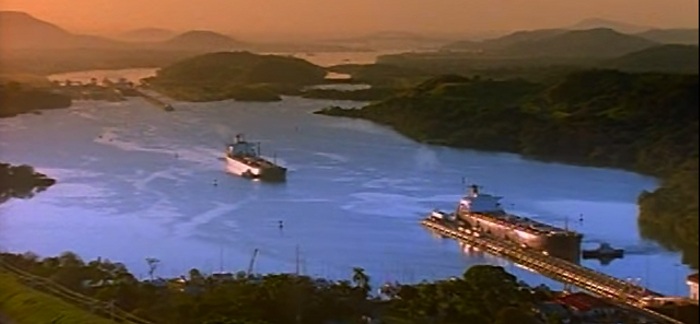Opened for the first time in August of 1914, the Panama Canal is one of the world’s greatest engineering achievements. It allows for shipping traffic to journey from the Atlantic Ocean to the Pacific Ocean without having to sail around the cape of South America. The journey may just be 50 miles long, but this American-built passageway saves ships over 8,000 miles of shipping time. At its time, it was the largest engineering project undertaken.
1. Find the Key
The Panama Canal is not just a navigable waterway that ships enter and exit on their own. There is a system of locks that is used to raise ships up to 85 feet above sea level at certain points along the voyage. Because the navigation on the canal is intricate and specific, every ship going through the passageway must bring on board a local captain or navigator based at the canal to guide the ship safely through.
2. An Oldie but a Goodie
The idea for the Panama Canal isn’t a 20th century moment of ingenuity. It’s something that was thought about for nearly 400 years before it was eventually completed. When Balboa came over from Europe to explore the area, he realized immediately how beneficial it would be to find a waterway that could link the two oceans. He searched for over 20 years to discover a natural way to travel across the Central American isthmus, but to no avail.
Because of Balboa’s observations, Charles V, who at the time was the Holy Roman emperor, ordered that a survey be completed to see if a canal could be built. In the 16th century, it was determined to be impossible. It’s the 20th century ingenuity that finally finished the project.
3. The Americans Weren’t First
The Panama Canal might have been built by the United States, but the Americans weren’t the first to attempt the project. That honor goes to France, who started their attempt at the canal in the 1880’s. Gustave Eiffel was hired to create a system of locks for the canal while Ferdinand de Lesseps worked on the canal itself. By 1889, plagued by tropical diseases, a lack of money, and very little progress, the project was abandoned when the companies funding it filed for bankruptcy.
The French government was less than pleased by this. With over $260 million involved in the project and nothing to show for it, the men involved were tried and convicted of fraud. Their sentences were eventually overturned, but it ruined everyone. A second company tried to continue the work, but soon found it difficult to manage as well.
4. The Nicaragua Canal?
When the United States was wanting a canal that could link shipping from the East Coast to the West Coast, it wasn’t Panama that the Americans were eyeing. It was Nicaragua. What changed the mind of the American government? Ironically it was a French engineer who had participated in both failed French versions of the project. Phillippe-Jean Bunau-Varilla lobbied the American government by telling them that Nicaragua wasn’t safe because of its high levels of volcanic activity.
Eventually the American lawmakers agreed. The US authorized the money to purchase the French assets in Panama in 1902.
Don’t give up on the Nicaragua Canal. The Chinese just paid the nation $40 billion for the rights to develop their own canal on the isthmus there.
5. A Place of Death
The Panama Canal was not easy to build. There were a number of challenges that faced workers in the 500 mile square zone that was assigned to the US. With rampant disease, heavy rains, and weather that was humid and hot, more than 25,000 people wound up dying from their efforts to establish the canal. To be fair to the US efforts, only 5,600 of the total occurred under their watch, but that is still one of the costliest projects in terms of lives that the US has ever undertaken. Most died from malaria or yellow fever.
6. War For Water
Everything looked good to begin developing the Panama Canal, but Colombia didn’t want that to happen at all. Many people don’t realize that Panama was actually part of Colombia at the time the canal was being developed. The US was not allowed by the Colombian government to begin developing the land, so the people of Panama staged a revolt. They declared their independence, setup a provisional government, and brought in the Americans.
It was one of Teddy Roosevelt’s more controversial decisions in retrospect. He fully supported the rebellion because of the American interests that were in the region. In total, the US spent $375 million to build the canal, including $10 million to the new government of Panama and $40 million ot purchase the French rights.
7. Lots of Ships
Although the Panama Canal is over 100 years old, it is still an essential component of the shipping industry. More than 13,000 ships tend to use the canal every year and in 2010, the 1 millionth ship used the canal. Most of the ships tend to be of American origin, but China, Chile, Japan, and even Colombia all regularly use the route. The Panama Canal charges each ship a toll to go through that is based on the size of the ship and how much cargo it is carrying.
The largest tolls tend to run about $450,000 for the biggest ships that are carrying the most amount of cargo. In 1928, the smallest toll that was ever paid to go through the Panama Canal was $0.36. It was paid by an American named Richard Halliburton. He wasn’t in a ship. He swam across the canal instead. In total, nearly $2 billion of revenues are collected annually from this marvel of engineering.
8. Have a Meal
With the system of locks that are in place and the intricate levels of navigation, it generally takes between 8-10 hours for a ship to make it through the Panama Canal. During this entire time, the specialized navigator is on the bridge of the ship, technically acting as that ship’s captain. Ships are not allowed to independently navigate on their own through the canal.
9. It’s Getting Bigger
The United States ceded control of the Panama Canal in 1999, but there are conditions in place that allow the US to defend the Panama Canal so that it will remain neutral. Panama has taken it upon themselves to expand the canal so that the megaships which sail on today’s oceans can also use the facilities. With a $5 billion plan in place, the canal will be able to handle a ship that is nearly 3x bigger than the largest ships that can go through the canal today.
The Panama Canal is one of the most innovative engineering projects that humanity has ever completed. It’s importance cannot be understated because it really is the one place in the world where East can meet West.




